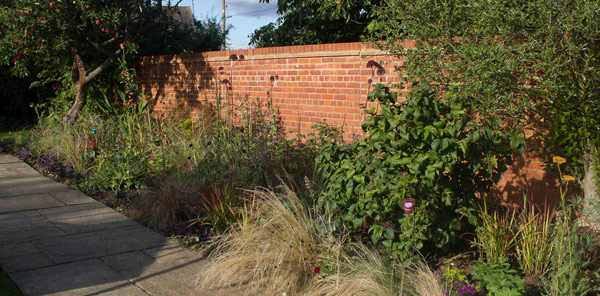September is often the most settled month of the year and after this year’s erratic weather, wouldn’t it be wonderful to welcome an ‘Indian Summer’, this month, with a month of still, sunny, days?
During the unsettled weather in August, I gambled on planting a mixed border, with the help of my friend, Paul, using new plants and some left over from the ‘Spirit of Longmeadow’, a garden created at BBC Gardeners’ World Live’ at the NEC, last July.
Gardening wisdom says that it is foolish to plant a border in August but I took the gamble based on the weather over the previous weeks and the forecast at the time. It was also prompted by the fact that the plants had been in their pots for far too long, were in danger of becoming pot bound and taking hours to water! The overcast, damp weather was perfect, (apologies to anyone who endured a rainy summer holiday!) now, the plants are making plenty of new growth and have several months to establish, before the onset of winter.
It proves one important point about gardening. If you assess the weather and soil conditions and are prepared to gamble, plenty of gardening operations can take place ‘out of season’ – seeds can be sown earlier or later with the same success and herbaceous plants can be moved almost any time of year, providing it is not too hot and dry. There is still time to apply weed-killer on the lawn, something you would perhaps expect to do in spring, not early September.
September is the traditional month for lawn maintenance. Now’s the time to raise the cut of your lawnmower, to scarify, aerate, feed with high potash fertiliser and ‘top dress’ with a mixture of loam and sharp sand. Spending time on lawn care is well worth while, preparing it for the rigours of winter and giving you a top quality lawn, next year.
It is also a good time to divide herbaceous plants – do this by pushing two forks, back to back, into the centre of the clump, forcing them together until they split, or dividing plants, like Hosta’s with an old kitchen knife.
Treating perennial weeds with glyphosate based weed-killer at this time of year, is particularly effective. Growth is starting to slow, so the treatment becomes more effective, as the chemical is taken right down into the roots. A word of warning: protect your treasured plants nearby, either by spraying on a still day or by covering their foliage with a board or piece of plastic sheeting. Any chemical which splashes onto your plants will affect them, too, so take care!
It is also an ideal time to take cuttings from tender plants for overwintering, in case we suffer from another cold winter and semi-ripe cuttings from plants like culinary sage or ‘cistus’. These cuttings are taken with a ‘heel’ – a small piece of hard wood at the base, which reduces the chances of ‘rotting off’ over winter.
You should also remove any apples or fruit showing signs of brown rot, particularly those hanging on the trees. This important task is often overlooked – mummified fruit left on the tree is a source of infection for next year. Happy Gardening and take care!
Matt


